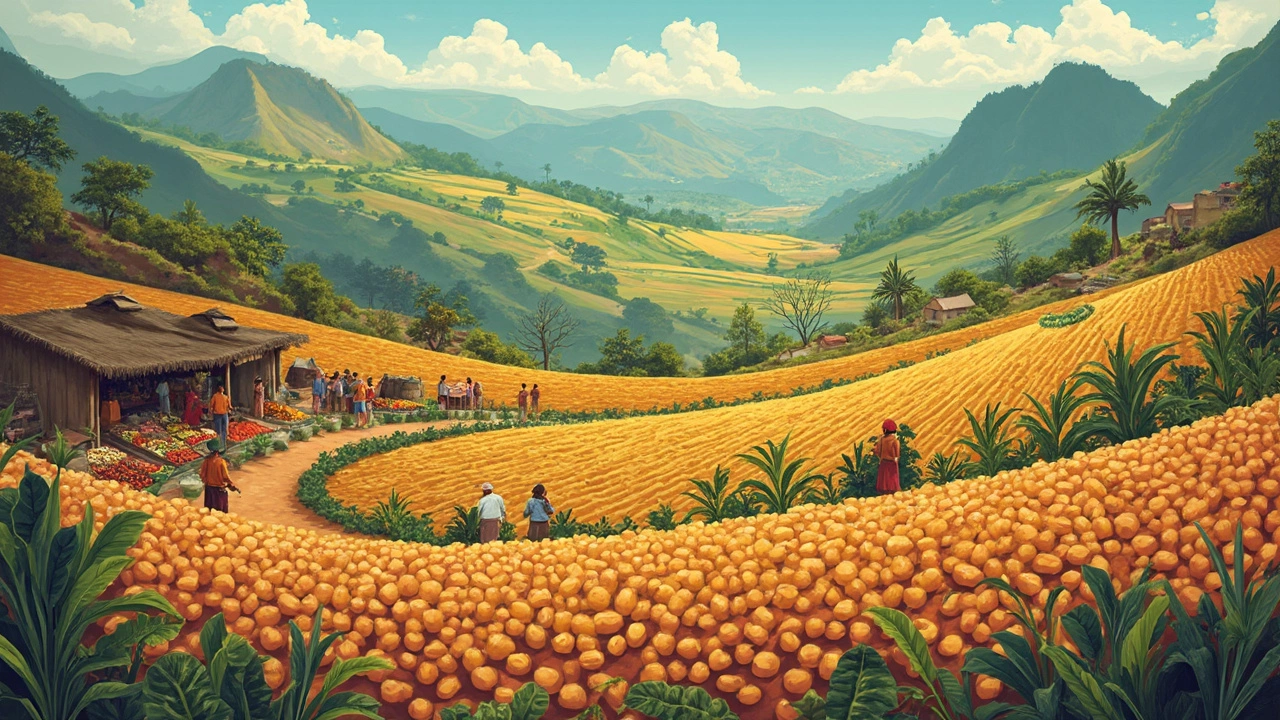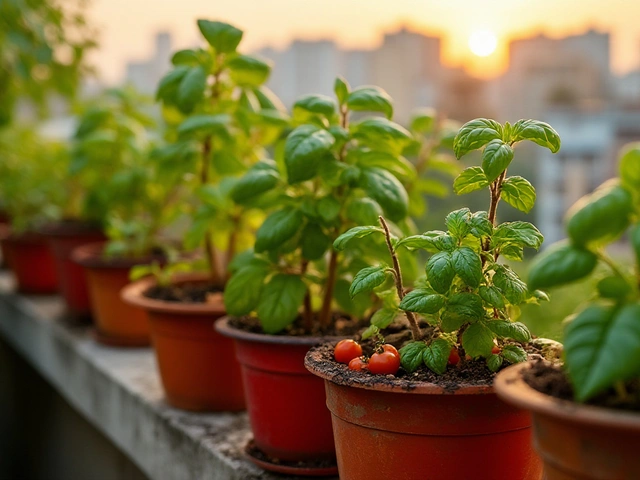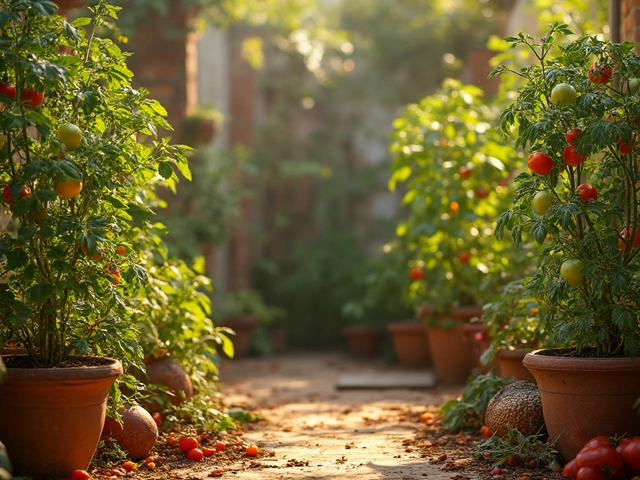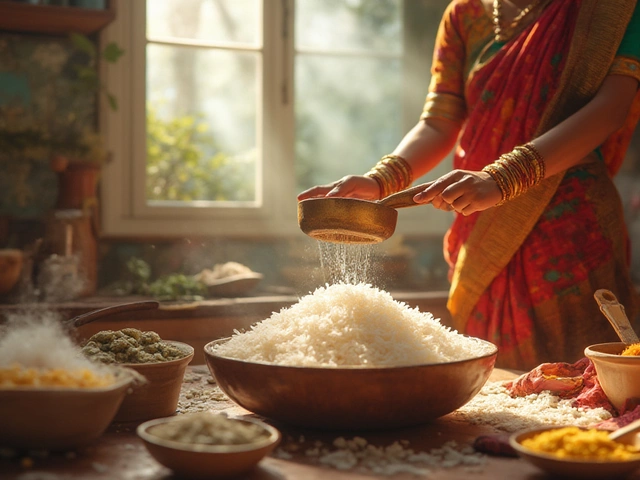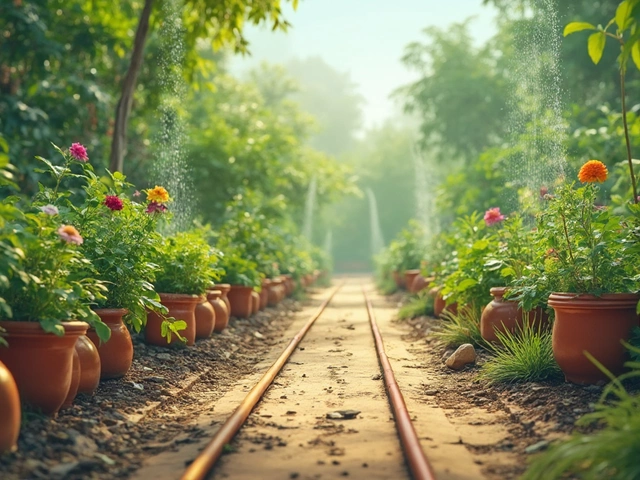Talk about comfort food, and you'll probably think of dishes like mashed potatoes, crispy fries, or maybe a hearty aloo curry. Now, here’s the question – ever wondered if these taters are originally from India? The story is a bit of a globe-trotter tale, and it starts far away in South America.
Potatoes are native to the Andes region in Peru and Bolivia. They’ve been in the game for over 7,000 years! So, no, potatoes aren't native to India. But what’s intriguing is how they traveled across oceans and terrains to become such a beloved part of Indian cuisine.
European explorers, particularly the Spanish, brought the potato over to Europe in the 16th century, and from there, it slowly made its way to India with traders and explorers eager to cultivate this versatile crop. By the late 18th and early 19th centuries, potatoes were cropping up in Indian fields, and before long, they rooted themselves deeply in the diet and culture.
- Where Do Potatoes Really Come From?
- How Potatoes Traveled to India
- Potatoes in Indian Cuisine
- The Potato Plant: Varieties in India
- Practical Tips for Growing Potatoes in India
- Common Challenges in Potato Cultivation
Where Do Potatoes Really Come From?
Alright, so you're curious about where these little starchy wonders potatoes originally come from. Spoiler alert: it's not from India! Let's head back in time to about 7,000 years ago. The cradle of our beloved spuds is the Andes region in South America, particularly in modern-day Peru and Bolivia.
Back then, the indigenous folks of the Andes were cultivating potatoes along with other crops. They knew a good thing when they tasted it! These early potatoes weren't just food, though. They were a big deal in ceremonies and had even found a place in traditional medicine. Talk about multi-purpose!
When Spanish explorers arrived in the New World in the late 15th century, they stumbled upon potatoes. Initially skeptical, they eventually took them back to Europe. By the mid-16th century, potatoes were spreading across the continent. It wasn't all smooth sailing, though. Europeans weren't quite ready to put potatoes on the menu, partly because they looked, well, a bit odd!
But then, one clever French dude, Antoine-Augustin Parmentier, really upped the ante on spuds getting popular in Europe. Fast forward a few more decades, and the trade routes had potatoes finding a home in Asia, Africa, and beyond. Thanks to these explorations and the global spice trade, potatoes eventually hit Indian shores, ready to make their mark and quite literally add spice to the culinary pot.
So, whenever you indulge in a serving of aloo tikki or a side of crispy, golden fries, remember that these humble roots traveled a world away to get to your plate!
How Potatoes Traveled to India
Alright, so let’s journey back to the 16th century. Our favorite spuds didn’t just appear out of the blue in India’s fields—they had quite the adventure! Potatoes were first discovered by Spanish explorers during their excursions to South America. They hitched a ride back to Europe, quickly capturing the attention of European farmers due to their ability to grow in various climates.
From Spain, potatoes spread across Europe, becoming a staple food item. The fun part? It wasn't long before adventurous traders began taking these tubers on their voyages. By the late 17th and early 18th centuries, Portuguese, Dutch, and British traders started bringing potatoes into Asia. These potatoes made their way to India through trade routes that connected the continent with Europe and the rest of the world.
But here’s the kicker: it was primarily the British East India Company that introduced potatoes in India on a larger scale. They realized the crop’s potential to sustain a growing population, so they pushed for its cultivation in Indian soil. Thanks to its adaptability, the potato thrived and soon became a central part of Indian agriculture and cuisine.
Within a few decades, potatoes were not just a novelty but a crucial element of the Indian diet. They adapted well to the diverse regions of India, finding a home from the cool slopes of the Himalayas to the sun-baked fields of the south. Today, thanks to that historical journey, India is one of the world's largest producers of potatoes, and an Indian dish without potatoes is almost unthinkable!
Potatoes in Indian Cuisine
When it comes to Indian cooking, potatoes in India have really carved out a niche for themselves. They're kind of like the MVP of veggies, playing a starring role in everything from roadside snacks to elaborate festival feasts. Let's dig into how these humble spuds became so central to the Indian kitchen.
Think of popular Indian dishes, and chances are you'll come across some hearty potato goodness. From your classic Aloo Gobi to spicy Aloo Tikki chaat, potatoes add that comforting carb bite that brings everything together. And they're not just filling bellies; they're adaptable to all sorts of flavors and spices found in Indian gastronomy.
Now, if you’ve ever had a North Indian meal, you probably know how stuffed parathas work. They’re these delightful whole wheat flatbreads that are usually loaded with spicy mashed potatoes. Man, they’re a breakfast staple in many parts of India. Add a dollop of butter or yogurt, and you’ve got a meal that's both simple and satisfying.
Let’s not forget about the street food scene. Walk through any busy lane, and you’ll likely bump into vendors serving up piping hot samosas. Those golden triangles are filled with deliciously spiced potatoes, sometimes mixed with peas or nuts for that extra crunch.
If you think potatoes are all about traditional fare, think again. These days, potatoes are going a bit global within India. Modern spins see them mashed and mingled in fusion foods, pairing Indian spices with international styles like potato wedges or tater tots.
Interestingly, the potato is pretty versatile in terms of preparation methods. You can boil, bake, fry, or even roast them. Each method brings out a different texture and flavor, allowing it to fit into a variety of Indian dishes.
And here’s a little something to chew on – in some states, especially during festivals or fasts, potatoes replace grains. Because they’re considered satvik or pure, they’re the go-to filling meal when folks are skipping grains and dairy but still need something hearty.
Frankly, potatoes have turned into a crucial part of meals across the country, not because they're show-offs but because they play well with others, letting spices and other ingredients shine while adding their own subtle charm to dishes. Whether you’re looking to make a classic curry or a creative new dish in your own kitchen, vegetable gardening in India wouldn't be complete without this tuber.
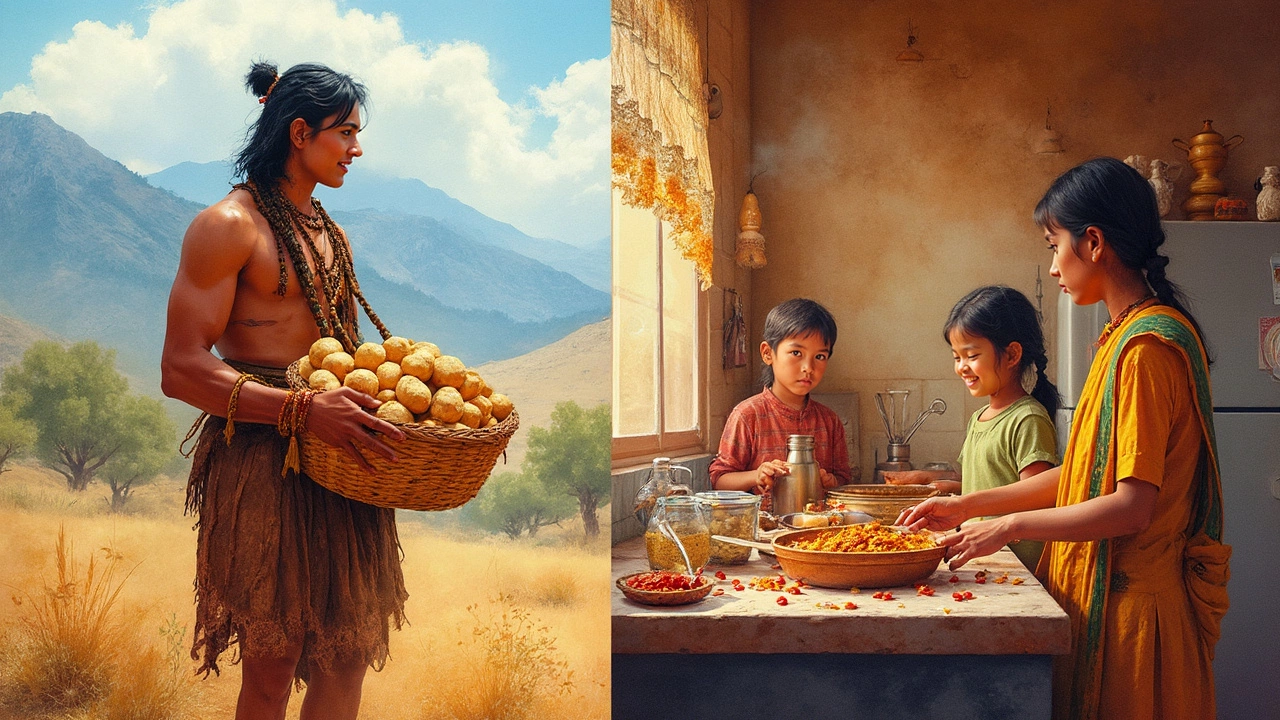
The Potato Plant: Varieties in India
When it comes to potatoes in India, there's a good mix of varieties available, each bringing its own flair to the table. Ever heard of Pokhraj or Kufri Jyoti? These are popular ones you might find in your regular vegetable market.
Pokhraj is a household name in parts of North India. It’s well-known for its good yield and disease resistance, making it a favorite among farmers. Its smooth surface and attractive color makes it a stellar choice for both kitchens and selling in markets.
Then there's Kufri Jyoti, originally developed by the Central Potato Research Institute. It's a true hero of high-altitude farming, thriving in places like Himachal Pradesh and Uttarakhand. This variety is a champion when it comes to tolerating diseases, which is a big deal for consistent crop production.
Another notable variety is the Kufri Pukhraj. It's all about quick returns. This variety matures earlier, which means farmers get to reap the benefits faster, and that’s why it’s favored in states with shorter farming seasons.
Wonder how these varieties fare in the market? Check this small table out:
| Variety | Growing Region | Special Feature |
|---|---|---|
| Pokhraj | North India | Disease resistance |
| Kufri Jyoti | Himachal Pradesh, Uttarakhand | Suitable for high altitudes |
| Kufri Pukhraj | Pan-India | Early maturity |
So, when you're planning your own little slice of vegetable gardening India, consider these types. They’re not just staples but have evolved, adapting perfectly to different Indian climates. Plus, they add variety to your home-cooked meals!
Practical Tips for Growing Potatoes in India
So, you're interested in growing some potatoes in India? Well, you're in luck, because it's totally doable with a bit of planning and care. Let's break it down into some simple steps to get you started on the right foot.
The best time to plant potatoes in India is generally between October and February, as the cooler months are ideal for potato cultivation. You’ll want to choose a spot in your garden that gets plenty of sunlight. Potatoes love light!
- Choose the Right Variety: Depending on where you live in India, different varieties might work better. Some popular choices are Kufri Jyoti and Kufri Pukhraj.
- Soil Preparation: Potatoes prefer loose, well-drained soil. Mixing in organic compost can work wonders to enhance soil fertility.
- Planting Your Seed Potatoes: Cut your seed potatoes into chunks, making sure each piece has at least one or two 'eyes' or buds. Let them dry for a day or two to prevent rotting.
- Plant Them Right: Dig a trench about 6-8 inches deep, and plant your potato pieces about a foot apart, covering them lightly with soil.
Watering should be consistent, but don’t overdo it – just enough to keep the soil moist but not waterlogged. Here's a useful tip: mulch! It helps retain moisture and keeps the weeds at bay.
An expert once said, "Potatoes are like people; they love company. If you plant them in a batch, they grow happier," shared Dr. Raj Patel, a noted horticulturist, during a gardening workshop.
Keep an eye out for pests like aphids and potato beetles, and deal with them early using organic pest control methods. Regularly inspect the plants to catch any issues before they get out of hand.
Want some numbers to chew on? Check this out – with good care, you can expect roughly a 5-8 kg harvest of potatoes for every kilogram of seeds you plant. That's a fair return on your gardening investment!
Once the plants have flowered and the foliage begins to turn yellow, it’s time to harvest. Gently dig them out, let them dry a bit, and then store them in a cool, dark place if you don’t plan to eat them straight away.
Common Challenges in Potato Cultivation
Growing potatoes in India isn't always a walk in the park. There're a few hurdles along the way, but don't worry—knowing them means you're better prepared to tackle them head-on.
One of the biggest issues faced by potato growers is dealing with pests like aphids and the infamous potato beetle. These pesky creatures love munching on potato leaves, so keeping an eye out is crucial. Consider using neem oil, a natural pesticide, to help fend off these unwanted guests.
Then there's the problem of diseases like late blight, which can totally ruin a crop. This fungal disease thrives in wet, humid conditions and spreads quickly. To minimize the risk, practice crop rotation and plant disease-resistant varieties. Keeping foliage dry by watering at the base of the plant instead of overhead can also help.
Another challenge is the soil itself. Potatoes need light, well-drained soil to grow properly. Heavy clay or overly wet soils can lead to poor tuber development or rot. If your garden soil isn’t ideal, build raised beds or add sand or organic material to improve drainage.
And let's not forget about the weather. Late frosts can be a nightmare once plants have started to grow. If a surprise frost is in the forecast, cover young plants with cloths or frost protection fabric overnight.
- Managing pests with natural solutions like neem oil
- Practicing crop rotation to avoid diseases
- Improving soil conditions for better drainage
- Protecting plants from unexpected frosts
Even with these challenges, with a bit of knowledge and effort, you can successfully grow potatoes in your garden. It’s all about tackling each problem as it comes and adjusting your strategies. Keep experimenting and don’t be afraid to try new techniques!
